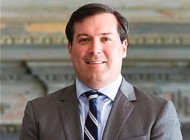
A gem of a small museum in Dover, Del., the Biggs Museum has a new director in Michael Dudich, who began his tenure within the past few months. Always curious to talk to the people who land in the top jobs, we reached out to Dudich to see what expertise he brings to the job and what plans he has up his sleeve for the museum.
You come to the Biggs Museum from the Wadsworth Atheneum in Hartford, Conn., where you were the deputy director of operations and its CFO. Where were you prior to the Wadsworth?
Before the Wadsworth, I was the Director of Administration and Human Resources at Hillwood Estate, Museum & Gardens in Washington DC. It was there that I made my transition from the corporate world having spent 25-plus years working my way up the management career ladder. It was also during my time at Hillwood that I became acquainted with the Biggs and was invited to join the board. If I had to pick a formulative moment before moving into the arts, I’d say my years at GE significantly shaped my leadership and business acumen. Changing locales has also been a big part of my life and a significant education in itself. Living in cities and towns large and small, in the United States and abroad, all memorable, but Savannah and Budapest were high on the list, then again, my husband and I are just getting to know Dover and the charm of Delaware’s beach towns.
The Biggs Museum has recently acquired 15/21 The Green. Can you tell our readers a little more about what that is and why it’s an important part of the Biggs Museum’s legacy?
With our focus being American Art with Eighteenth and Nineteenth Century works at our core, acquiring two properties on the National Historic Register fronting Dover’s Historic Green, allows us to rethink the ways in which we engage both with the collection and the public. We’ve already taken the first step, launching a Facilities Master Planning Process to evaluate the new buildings, along with the existing Biggs facility in order to come up with innovative ways to integrate the structures and meet community needs. We’re planning more than a dozen community listening sessions to help shape and guide the outcome. Animating our place on The Green by delivering a thoughtful, approachable, and integrated museum, a cultural resource for Delaware, is at the forefront of our efforts.

“Sunny Day – Milton” by Tom Wilson, 1983, oil on canvas.
In an April 2022 article in Delaware’s Cape Gazette, you were quoted as saying, “It is thrilling to have the opportunity to lead the Biggs into its next chapter.” Can you elaborate a little more on what you’d like that new chapter to look like? Plans you have?
Creating a new museum experience by repositioning our physical spaces is a great opportunity in itself but looking at the ways in which we connect with people to grow audience is equally as energizing. We’ll be spending a lot of time talking about what defines American Art and the ways in which we can expand the collection, programing and exhibition offerings to more fully represent its breadth. I am fortunate that I have a great team to help me sort out the specifics and chart the Biggs’ path. Coming out of the pandemic, I’m encouraging them to resist the temptation of simply reverting back to normal, to that place that feels comfortable. I recently heard a phrase that keeps resonating with me, “Be the museum of the future now.” Too much has changed for us to think we won’t keep pivoting.
Is there anything else that’s new and exciting taking place, or in the works for the Biggs?
Showcasing artists who contributed significantly to Delaware’s arts and culture legacy is a major part of our mission. We are doing that in a big way right now with an exhibition featuring realist/surrealist, Tom Wilson (1946-1995). Born in Delaware and educated at the Rhode Island School of Design, ironically Wilson’s fame didn’t begin at the easel but in front of the camera as a top male fashion model in New York and Paris. He was heralded in the 1970s as “Vogue’s favorite guy.” Then, in 1980, he gave it all up, moving back to his family’s Lewes, Del., beach cottage to paint, embracing the fields of grain, sun-bleached buildings, quaint homes, thrift stores and the diversity of local characters to produce a vivid body of work. What makes Wilson’s inaugural show, assembled through 50 private loans, all the more interesting, is that he rarely sought gallery representation during his career. His sales were driven by his distinctive character as well as his talent that was regularly on display on the walls of a local Rehoboth Beach restaurant, The Back Porch Café. Tom Wilson was not only talented, but beloved. I couldn’t have hoped for a better exhibition to begin my tenure as director.
-Madelia Hickman Ring




